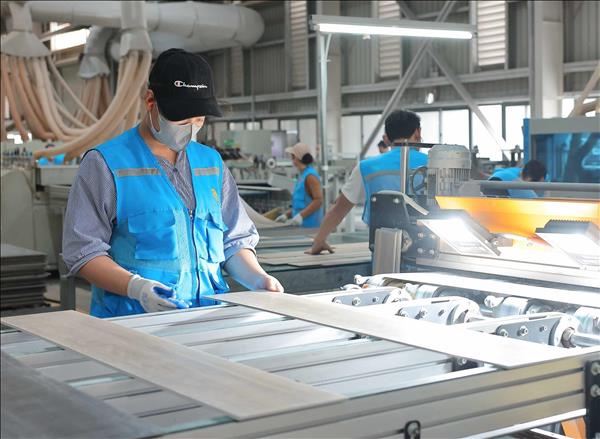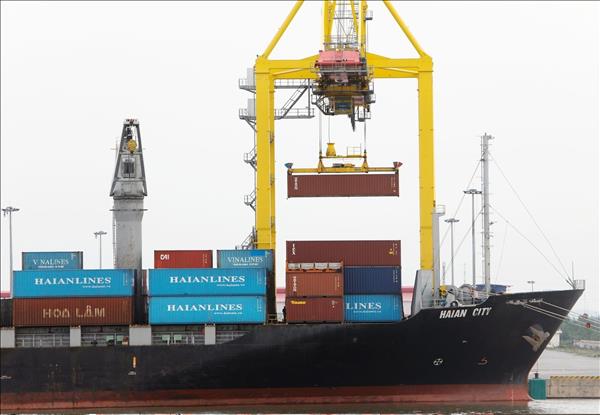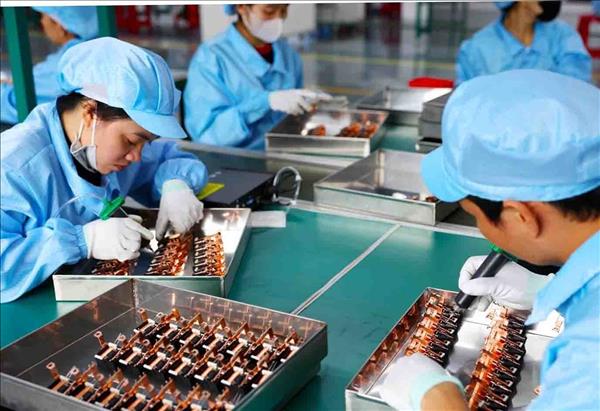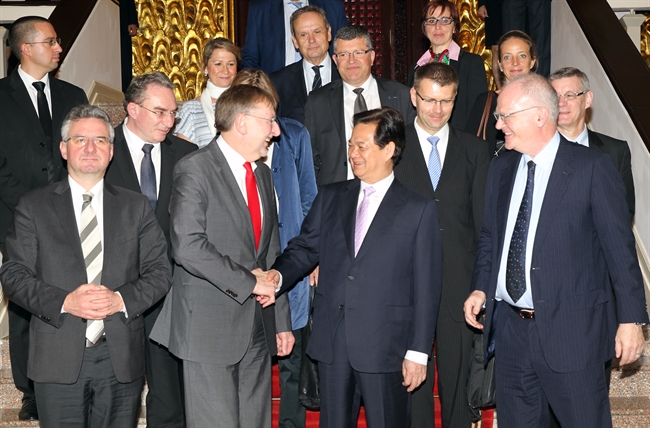
During talks with Prime Minister Nguyen Tan Dung in Hanoi (April 2015),
Chairman of the European Parliament (EP)’s International Trade Committee Bernd Lange highly appreciated
Vietnam’s commitments and specific road map for EVFTA negotiations and enforcement after its signing and ratification.
Photo: Duc Tam/VNA
According to MoIT, right after the FTA is enacted the EU will erase the import tax for about 85.6 percent of the taxed goods, equivalent to 70.3 percent of Vietnam’s export value to the EU.
The figures will increase to 99.2 percent and 99.7 percent, respectively, after the FTA has been implemented for seven years.
For the remaining 0.3 percent of Vietnam’s export value to the EU, the EU pledged to grant Vietnam tariff quotas, of which the import tax will be reduced to zero percent.
For key commodities such as textiles and garments, footwear and seafood (excluding canned tuna and fish balls), the EU will erase the entire import tax for these Vietnamese exports after the FTA has been implemented for seven years.
The EU also agreed to offer Vietnam appropriate tariff quotas for the canned tuna, husk or no-husk, and fragrant rice exports. Rice exports to the EU under these quotas will be totally taxfreed. For broken rice exports in particular, the tax reduction will be implemented according to the set road map. The EU will reduce the import tax on Vietnamese rice down to zero percent within seven years.
When the EVFTA is enacted, the EU will abolish tax on Vietnamese honey and will not apply the tariff quota to this product. In addition, Vietnamese fresh vegetables and fruit, processed vegetables, fruit and fruit juices; bags, suitcases; plastic, glass and ceramic products will also apply to the tax-free scheme.
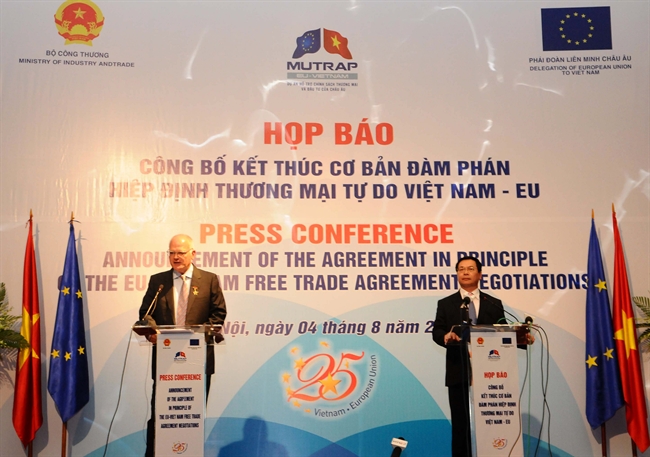
Minister of Industry and Trade Vu Huy Hoang and Head of the EU Delegation to Vietnam Ambassador Franz Jessen
at the press conference to announce the agreement in principle of the EU-Vietnam Free Trade Agreement . Photo: Tran Viet/VNA
at the press conference to announce the agreement in principle of the EU-Vietnam Free Trade Agreement . Photo: Tran Viet/VNA
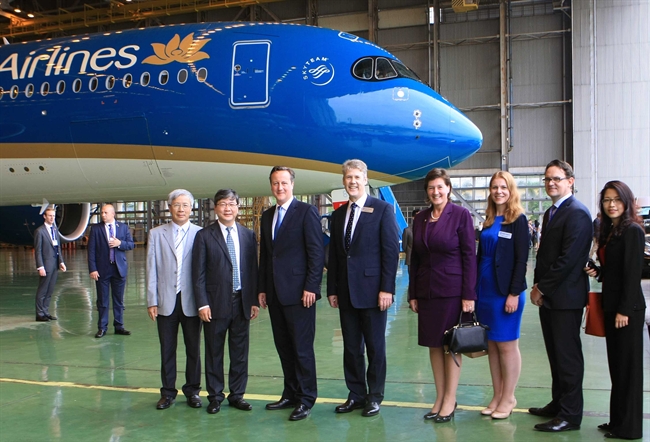
On the visit to Vietnam by UK Prime Minister David Cameron, Rolls-Royce and Vietnam Airlines signed
an engine servicing and maintenance contract for 14 Airbus A350 XWB aircraft of Vietnam Airlines.
Photo: Doan Tan/VNA
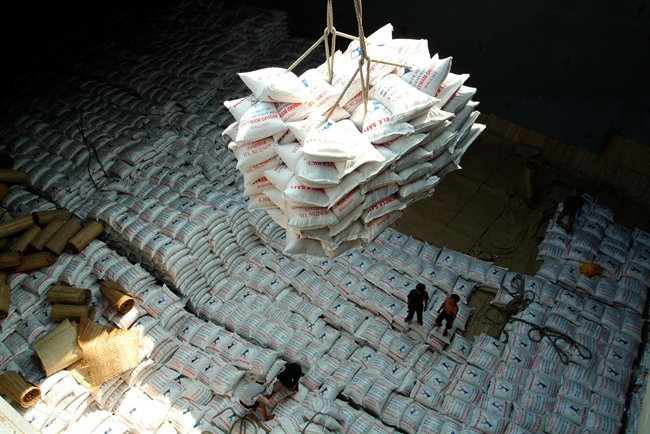
EU will set aside large quotas for Vietnamese processed rice once EVFTA takes effect. Photo: Quang Minh/VNP
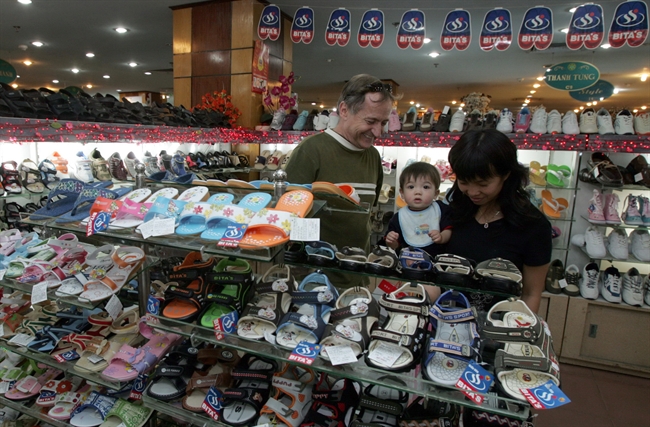
The EU will eliminate duties on Vietnam’s footwear over a seven-year period after EVFTA takes effect. Photo: VNP File
The EU will lift all import taxes for Vietnam’s seafood excluding canned tuna and fish ball
in seven years after the EVFTA takes effect. Photo: Le Minh/VNP
In return, Vietnam pledged to reduce taxes to zero percent for EU’s cars and motorbikes exported to Vietnam after the FTA has been implemented for nine or ten years. EU’s motorbike exports to Vietnam having a cylinder volume from 150 cubic centimeters and over will enjoy a road map tax reduction within seven years.
For EU’s products of wine, alcohol, beer, pork and chicken, Vietnam agreed to delete most of the import tax after the FTA is enacted for ten years at most.
Regarding the export tax, Vietnam pledged to abolish most of the export tax which will be implemented according to a set road map, and only to maintain the export tax on some key commodities, including crude oil and coal.
In other contents related to commercial goods, Vietnam and the EU agreed upon contents for customs procedures, issues of Sanitary and Phytosanitary (SPS), Technical Barriers to Trade (TBT), trade protection and others, making a legal framework for cooperation between the two sides and providing favorable conditions for their businesses’ import and export activities.
According to MoIT, in the fields of trade, services and investment, Vietnam and the EU pledged to create an open, favorable environment for investment from both sides. Vietnam’s commitments in the signed EVFTA are far beyond those it had made with the World Trade Organisation (WTO). Meanwhile the EU’s commitments are also stronger than those it made with the WTO and similar at the highest level it had made in other FTAs it had signed recently.
The areas in which Vietnam pledged to make favorable conditions for the EU investors included specific services, financial, telecom, transport, and delivery services.
The two sides also set forth commitments to treat each other at the national level in the investment field and discuss contents to solve disputes between investors and governments.
In term of the governments’ procurement, Vietnam and the EU agreed upon contents similar with those of the WTO’s Agreement on Government Procurement (GPA). To implement its obligations in e-bidding or opening websites to provide information of the tenders, Vietnam has built up a road map and the EU also pledged to support Vietnam technically to implement those obligations. Vietnam will maintain its right to reserve a certain rate of the bid packages’ value for domestic contractors, laborers, services and goods.
Regarding intellectual property, the commitments included those on copyright and inventions, on pharmacy and geographical instructions... Basically, Vietnam’s commitments on intellectual property are in line with its current legal regulations.
In regard to geographical instructions, when EVFTA is validated, Vietnam will protect EU’s 160 geographical instructions (from 28 members) while the EU will protect Vietnam’s 39 geographical instructions. Vietnam’s geographical instructions are about farm produce and foodstuff, which help some categories of Vietnamese farm produce build and confirm their brand names in the EU market.
EVFTA also comprises chapters related to competitiveness, state enterprises, sustainable development and cooperation in building capacity and legal, institutional issues. These contents conform with Vietnam’s current laws and legal regulations, providing a legal framework for the two sides to strengthen cooperation and speed up bilateral trade and investment.
|
|
By VNA/VNP
phamtrangnhung


